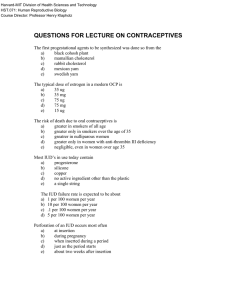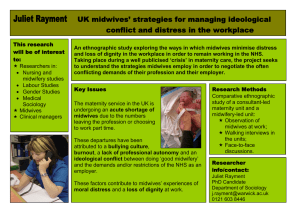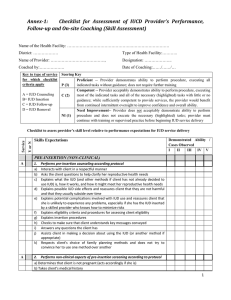Emily Brandl-Salutz Bixby Summer Fellowship Follow-up
advertisement
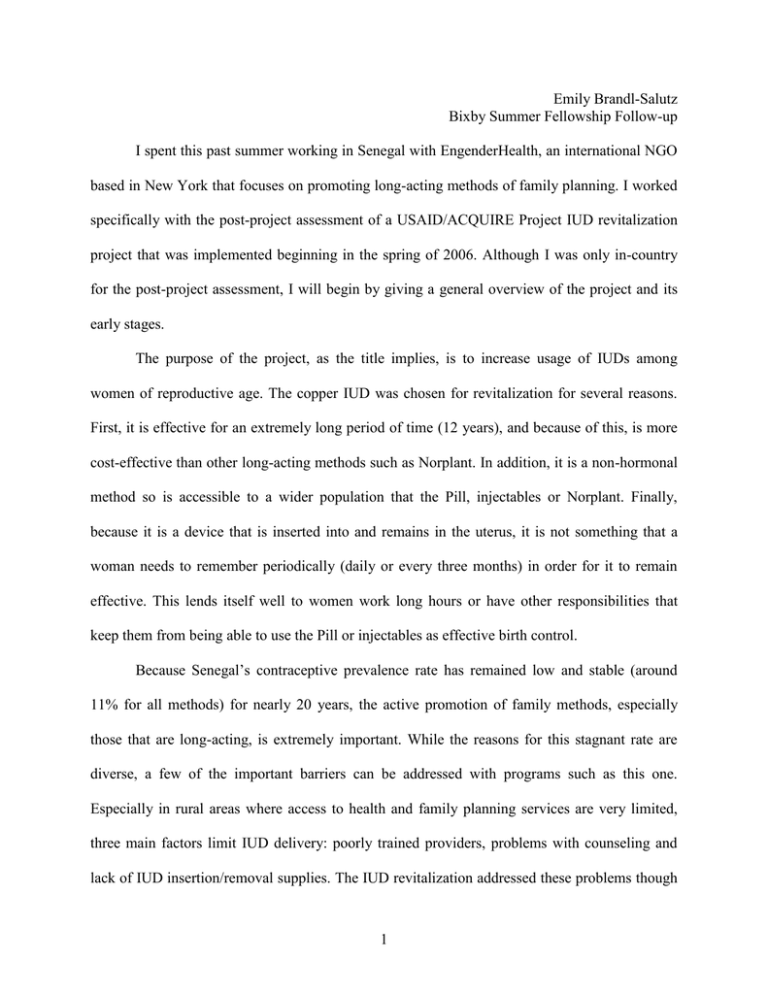
Emily Brandl-Salutz Bixby Summer Fellowship Follow-up I spent this past summer working in Senegal with EngenderHealth, an international NGO based in New York that focuses on promoting long-acting methods of family planning. I worked specifically with the post-project assessment of a USAID/ACQUIRE Project IUD revitalization project that was implemented beginning in the spring of 2006. Although I was only in-country for the post-project assessment, I will begin by giving a general overview of the project and its early stages. The purpose of the project, as the title implies, is to increase usage of IUDs among women of reproductive age. The copper IUD was chosen for revitalization for several reasons. First, it is effective for an extremely long period of time (12 years), and because of this, is more cost-effective than other long-acting methods such as Norplant. In addition, it is a non-hormonal method so is accessible to a wider population that the Pill, injectables or Norplant. Finally, because it is a device that is inserted into and remains in the uterus, it is not something that a woman needs to remember periodically (daily or every three months) in order for it to remain effective. This lends itself well to women work long hours or have other responsibilities that keep them from being able to use the Pill or injectables as effective birth control. Because Senegal’s contraceptive prevalence rate has remained low and stable (around 11% for all methods) for nearly 20 years, the active promotion of family methods, especially those that are long-acting, is extremely important. While the reasons for this stagnant rate are diverse, a few of the important barriers can be addressed with programs such as this one. Especially in rural areas where access to health and family planning services are very limited, three main factors limit IUD delivery: poorly trained providers, problems with counseling and lack of IUD insertion/removal supplies. The IUD revitalization addressed these problems though 1 training of midwives from 16 district health centers in IUD counseling and insertion/removal, and the provision of IUD kits and visual aids for counseling. To prepare for the implementation of the training portion of the program, several background activities took place. First, initial site visits were made to assess baseline conditions at the chosen health centers. A standardized survey tool was used to ensure consistency across sites and comparability with information gathered during future visits. Second, a three-day meeting was held to update, discuss and standardize the curriculum to be used for the midwife IUD trainings. The first training for midwives was held in Dakar at the end of July 2006, the second at the end of August. Both spanned 5 days. The training was composed of several components including: general information about the IUD and eligibility for the method, infection prevention, patient exam, proper insertion and removal techniques (including practice on a pelvic mannequin), and proper counseling techniques. Although all of the participating midwives were state-certified, the national curriculum does not place much emphasis on family planning, especially in regards to counseling and practical techniques. Through this training, the midwives were able to gain or renew their IUD skills. In the original program plan, two supervision visits were supposed to be completed in the year following the initial training of the midwives. Unfortunately, this did not take place. Instead, only one supervision visit was completed in March 2007, nearly seven months after their training was completed. In addition, the survey tool used to assess the baseline conditions at the centers was not used. Instead, a different document was used and made the conditions of the health centers at this time point impossible to compare with the baseline and post-project findings. During the visits to the health centers, it was also found that many of the midwives were absent 2 at an ultrasound training in Dakar, making accurate assessment even harder. The late supervision date also made changes to problems found at the centers impossible to address before the end of the project. The portion of the project with which I was involved, the post-project assessment, took place at the beginning of July 2007 after many delays. The standardized survey tool that was used to assess baseline conditions at the centers was also used during this portion of the project. In addition to the survey, IUD insertion and removal technique using the pelvic mannequin was also observed to ensure retention and proper practice of clinical methods. As during the first supervision, some of the midwives were absent from their posts because of ultrasound training in Dakar. While it was impossible to assess improvement and performance of the midwives in relation to the baseline while in the field, I found this portion of the process extremely rewarding. I had spent the previous part of the summer in the office struggling to get the assessment organized and scheduled, which was not an easy task since so much was out of my control. Also while in the office, I had plenty of time to analyze the project and find faults in implementation. However, despite all this, I was able to see the importance of the project in context, even if only 16 midwives had been trained. From the personal stories told to me by the midwives about the importance of the training, I was able to get a true sense of its importance, even if its implementation was a bit lacking. Upon returning to the office, I worked on our final trip report and compiling of the postassessment numbers for comparison with baseline. Again, despite its small scale, I was happy to see improvement in the conditions at the health centers in relation to IUD provision. Here are 3 some of the most notable accomplishments (these are sometimes hard to quantify because of the quality of data collected): Addition of 5 health centers that offer IUD services All centers put into place a referral system for other non-available methods of family planning Marked increase in midwives who help a client assess their HIV and STI risk Marked increase in midwives who perform speculum/bimanual exam before insertion Marked improvement in infection control While half of centers didn’t have all supplies necessary in order to provide IUD services at baseline, all had the necessary supplies at post-project assessment Despite my frequent frustrations with this project, in hindsight, I’m very grateful for the experience. I got plenty of experience in project analysis, dealing with and trying to improve conditions beyond my control, and being patient! Outside this project, I got the opportunity to attend two conferences, meet people from other organizations working in family planning in Senegal, gain a better context of family planning within the specific cultural context of the country through discussion and reading. These, along with working in the field, were my learning goals for the summer and I successfully accomplished them. 4
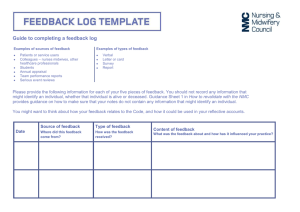
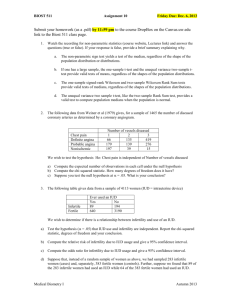
![Letter to MPs re: maternal mental health report Dear [Name of MP] I](http://s3.studylib.net/store/data/006839335_1-7d7b3127aade7ad6d126565942ce75c1-300x300.png)
